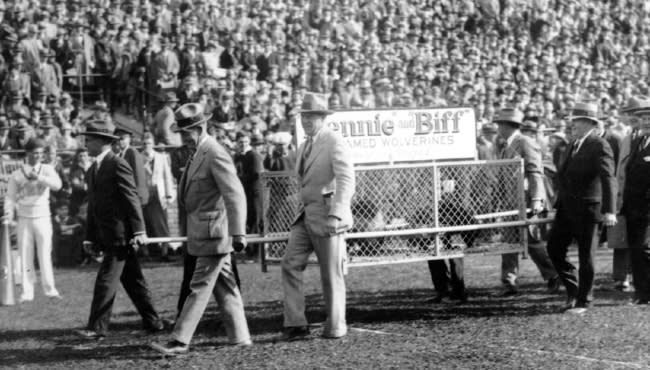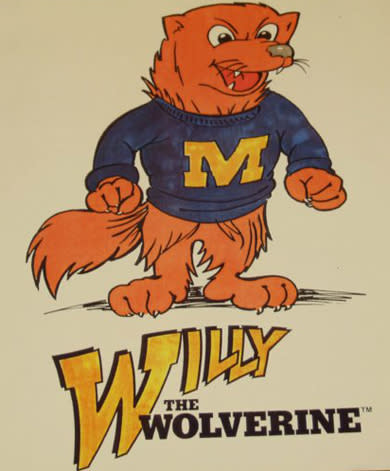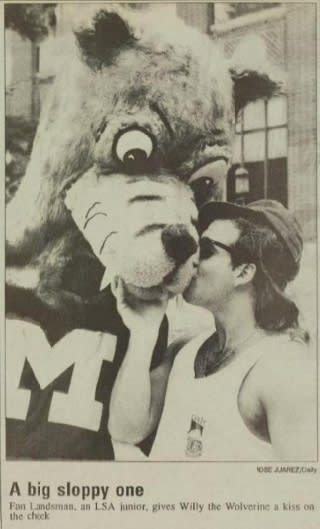Why don’t the Wolverines have a mascot?

- Oops!Something went wrong.Please try again later.
GRAND RAPIDS, Mich. (WOOD) — The latest installment of Nissan’s “Heisman House” ad campaign picks at a nit that has bothered some Michigan fans for years. Why doesn’t the school have a sideline mascot?
While Michigan doesn’t have one now, that wasn’t always the case. And — as Eddie George can attest in the commercial — that may be for a good reason.
There have been two notable periods when Michigan did have a mascot “roaming” the sidelines. A wolverine was first brought to Michigan Stadium thanks to the man who set the foundation for the program: Fielding Yost.
According to the Bentley Historical Library, Yost started his search for a live mascot in 1923 after a game against Wisconsin. The Badgers brought a live animal along with its team, and what could be more intimidating than an actual wolverine on the sidelines?
Michigan historian Greg Dooley says Yost contacted more than 60 trappers to see if anyone could catch a live wolverine. Years later, Yost would get his wish. In 1927, 10 wolverines were captured in Alaska and placed in the Detroit Zoo. On big game days, two of the wolverines were brought into Michigan Stadium and paraded around in a cage — dubbed Bennie and Biff, Michigan’s official wolverines.
Incredibly, according to an article in The Michigan Daily student newspaper, before the Nov. 12 showdown against Navy, game organizers planned to bring Bennie and Biff out to midfield on leashes to meet Navy’s live goat mascot. They also tried to fit the animals with steel jackets to help keep them under control.

Shockingly, neither idea worked out well. Bennie and Biff were quickly benched.
Said Yost: “It was obvious that the Michigan mascots had designs on the Michigan men toting them, and those designs were by no means friendly.”
Michigan’s long Rose Bowl history: The early years
But the prolific coach and athletic director never gave up his dream for a live wolverine mascot. In 1939, Yost got another shot. Chevrolet donated a wolverine to the university to be housed at the campus zoo. The zoo officials agreed to care for the animal on one condition: that the wolverine cannot be brought to any sporting events.
“The excitement, museum officials thought, would be too much for the animal,” zoo officials told The Michigan Daily.

The wolverine, named Intrepidus, or “Treppy” as he was affectionately known, made his lone Michigan Stadium appearance at the 1939 season opener against Michigan State.
With Treppy hanging out at the campus zoo, the call for a sideline mascot cooled for decades. But in the 1980s, a group of students came up with a new idea. Using a live wolverine isn’t feasible, but what about a big, fuzzy costume to embody the beast?
Michigan’s long Rose Bowl history: Highs and lows
A group of three Michigan students — Adam Blumenkranz, Eric Lefkofsky and David Kaufman — went outside the box and created as mascot on their own, without involving the university.
The trio used market research to design it: a fuzzy, friendly looking animal that looked more like a wolf or a fox than a wolverine. Willy the Wolverine walked on two legs and sported a dark blue sweater with a large maize “Block M.”

According to a 2011 blogpost by Michigan Today, the trio and Willy’s supporters pushed the athletic department to adopt the new mascot, but they turned down meetings saying the university “wasn’t interested” and eventually banned the Willy mascot because the 7-foot-tall costume blocked other people’s view of the field.
Willy’s creators were undeterred. They obtained trademarks for Willy the Wolverine and started selling merchandise and continued to boost their creation across campus. In 1989, Willy served as the grand marshal for the homecoming parade. The following year, Willy posed alongside the cheerleading squad for the cover of the campus directory.
He wasn’t universally beloved, however. The Michigan Daily published two pieces from staffers arguing for and against Willy the Wolverine. Rich Eisen, who was the sports editor for the Daily before going on to a long career at ESPN and the NFL Network, argued against having a mascot — calling Willy a “fuzzball goof.”
“There’s more than enough spirit at Michigan sporting events already,” Eisen argued. “Michigan fans aren’t ignorant; they don’t need any fuzzy pituitary case named Willy telling them how they should feel about their team. Tradition is what makes Michigan fans feel proud, not some mascot.”
Twenty years later, when athletic director Dave Brandon raised the possibility of introducing a mascot, Eisen revisited his old remarks and stood by them, saying on Twitter that, “Michigan should always be a mascot-free zone.”
The fight over Willy the Wolverine culminated in 1992 when the university filed a lawsuit against Willy’s creators, issuing a cease-and-desist for using copyrighted material owned by the university.
For the latest news, weather, sports, and streaming video, head to WOODTV.com.
